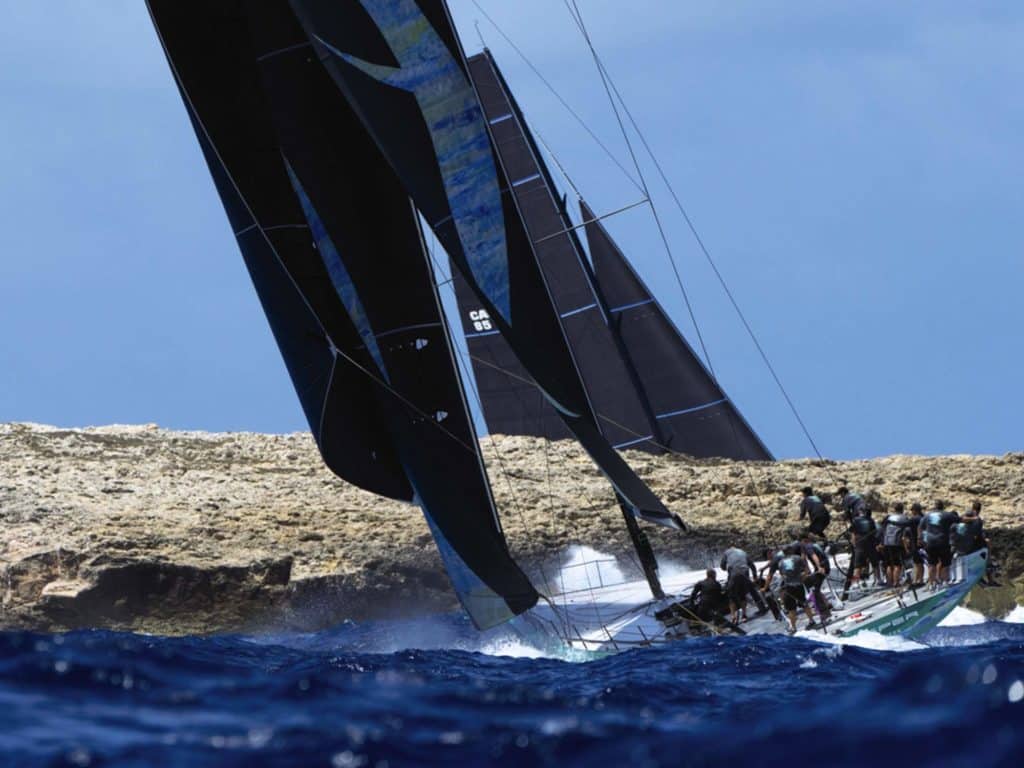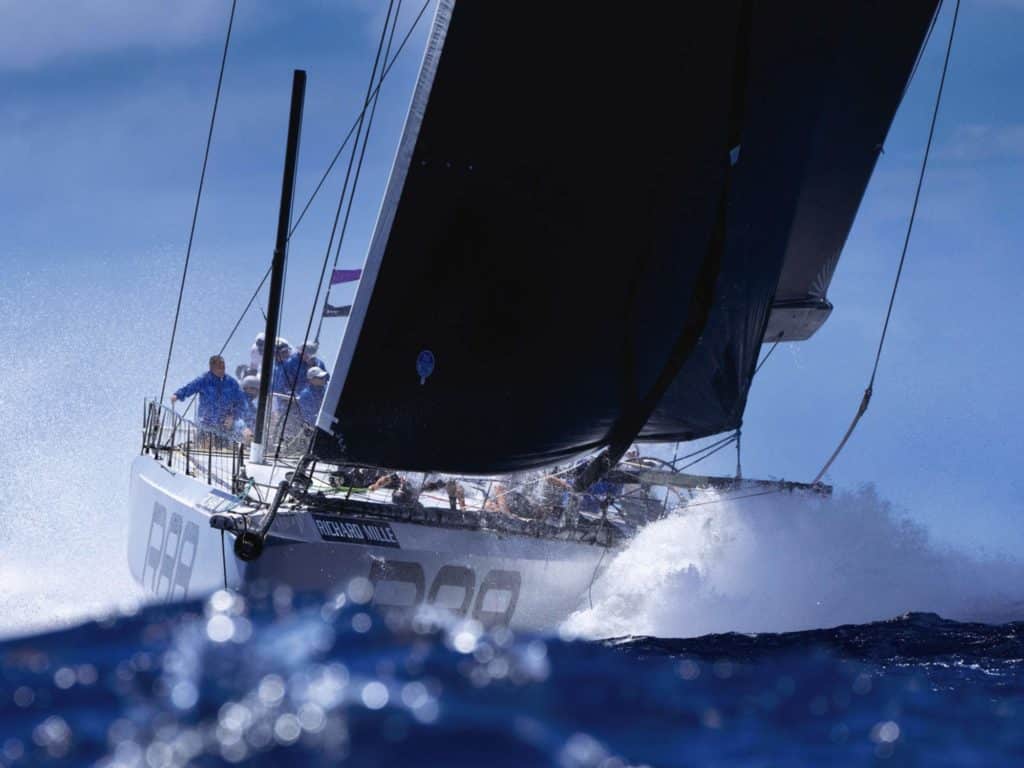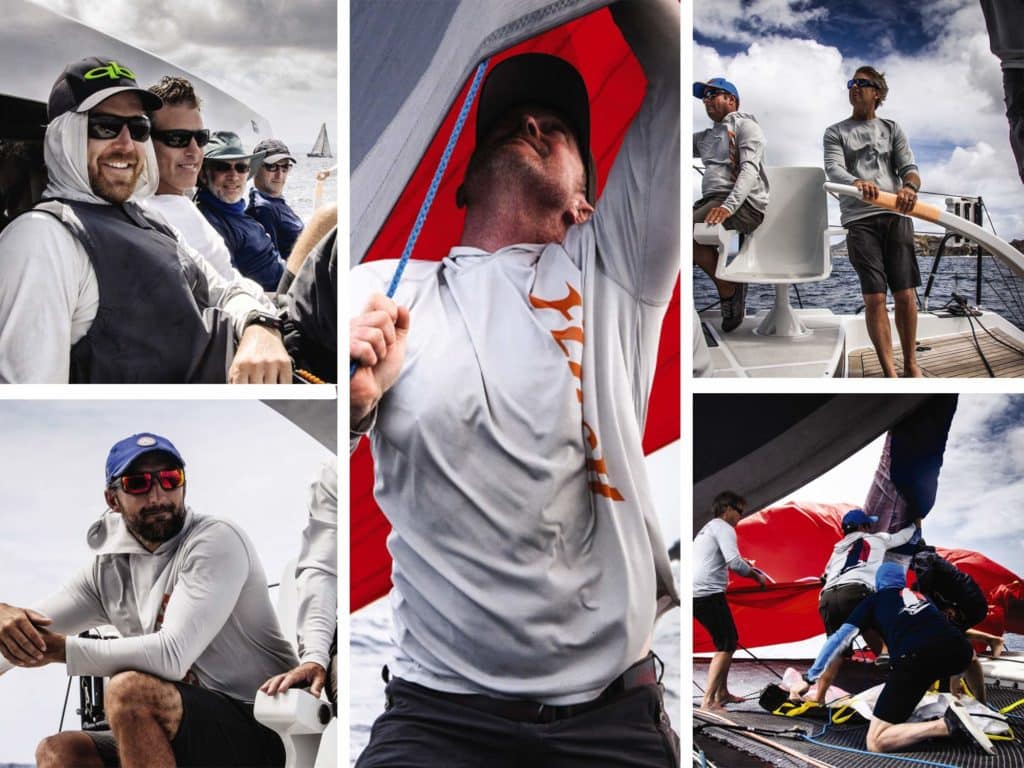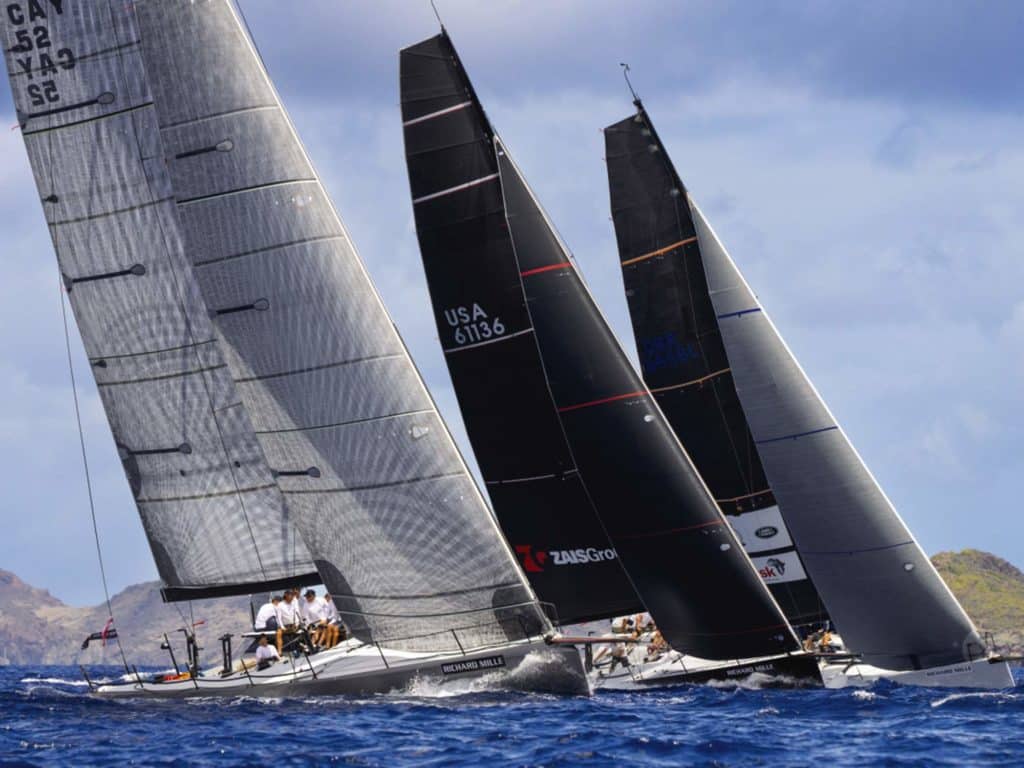
As David Welch peels foil wrap from the neck of a Champagne bottle he’s just stepped off the stage with, he advises his teammates to step back. His crew, in matching blue T-shirts, fan out into the shoulder-to-shoulder crowd inside the regatta village at St. Barts’ Gustavia Port Marina. He wrestles the cork free, and with a muted pop, it soars into the star-filled sky above. Welch’s grin is ear-to-ear as he fills the plastic cups of his crew and toasts his team’s success at Les Voiles de St. Barth Richard Mille.
Judging the enthusiasm of this impromptu celebration, you might think Welch and his teammates had won their five-boat offshore multihull division—but no, that honor goes to Kent Haeger’s team on the undefeated silver Gunboat 62 Mach Schnell. Still, on the fifth and final day of this grind of a Caribbean regatta, Welch and his crew on the HH 66 catamaran Flash have sailed their best race. More importantly, they and their boat persevered where so many others failed in St. Barts’ big-breeze, trade-tossed seas, eight-hour race days and nightly soirees.
“This is definitely a war of attrition,” Welch says, “but the sailing… It really is incredible.”
That’s the one statement heard round the waterfront at Les Voiles de St. Barth, now 11 editions running. It’s a unique regatta, with winners and losers up and down the scoreboard. But as the cliché goes in the upper echelons of sailboat racing, “yachting is winning,” and when it comes to yachting on the blue waters surrounding this fantasy island of wealth, beauty and charm, everyone’s winning. Put it this way: First, second, third or dead last are equally Champagne-worthy.

Thus, corks soar over the course of the hourlong awards fête, just as they were a few days earlier when dozens of the sailors gathered for the legendary Nikki Beach lay-day party, where oversize sushi boats sail from the kitchen to beachside tables, and waiters wander with rosé rehoboams slung over their shoulders, refilling glasses as if it were water. Tug of wars between leg-bruised and bikini-clad crews and the hulking grinders of the big boats follow the traditional Champagne scavenger hunt, where sailors rush into the surf and dive for bottles tethered to the seafloor. It’s a scene.
Pop, pop, pop, all afternoon. The attrition continues.
Not everyone is into the whole Nikki Beach bacchanal. Others have scattered across the 10-square-mile island to pristine beaches, hillside villas with infinity pools, and the restaurants, boutiques and cafes that give this French outpost its reputation as the glitziest getaway in the Lesser Antilles. If it weren’t for the easterly trade winds blowing streaks of sargassum across the racecourse, you’d swear you were racing in the Med.
Les Voiles has everything wanting of an upscale and Med‑caliber regatta too, and the late-April race week’s reputation for big breeze, big waves and high-quality race management attracts the elite of the yacht-racing world, as well amateur teams that sail to the island on their own bottoms, or sign on to charter boats, tie up stern-to Gustavia Harbor’s seawall, and endure sleepless nights riding the surge. Late-night boarding can be so perilous that piles of sail bags and crew gear often suffice as bedding to sleep off a boozy night.
But enough of the afterhours. This regatta is physical racing, and an estimated 900 sailors are here to play hard. Sixty-eight teams have signed on for this edition, spread across six Caribbean Sailing Association (the regional handicapping system) divisions, two multihull classes and a Diam 24 one-design trimaran class. The crown jewels of the regatta are the glamorous Maxis, moored in the deeper water of the outer harbor. This year, there’s George David’s silver Rambler 88; Jim Schwartz’s mint-green Maxi72, Vesper; Hap Fauth’s dark-blue Bella Mente; and the newest of the fleet, Wendy Schmidt’s 80-footer, Deep Blue. The full might of the American Maxi fleet is present, each loaded with 20 or more professionals. Having arrived midweek, just in time for the Thursday lay day, I’ve hitched two very different rides for the remaining two days: Welch’s Flash and David’s Rambler 88.
Chris Battaile, a professional boat captain who commissions and manages the big cruisers and racers for HH Catamarans, picks me up from the seawall at 0900 as planned and shuttles me out to the big blue catamaran where I meet the crew: a mix of friends and professionals, including America’s Cup veteran and US SailGP Team wing trimmer Paul Campbell-James.
Welch, a fiber-optics engineer and social philanthropist from Los Angeles, is relatively new to this whole big-cat racing thing, but he’s hooked and tells me he’s on the hunt for something bigger and faster. So far this week, his family cruising boat has been unable to match the pace of Mach Schnell or the space-age-looking Fujin, campaigned by Greg Slyngstad. The results are getting repetitive: one, two and three across the line no matter how hard they try. Flash’s sailmaker, Alan McGlashan of Doyle Sails, opines they’re plenty quick upwind, but lack the proper downwind sail. The boat’s butchered red spinnaker-in-a-sock (not built by his employer) is more triangular, he says, and would be better served as a tarp. They’ve rigged a system to pull the spinnaker tack to weather to get it out from behind the giant mainsail, but even that’s not helping much.
The day’s course is a 29-miler that starts outside Gustavia Harbor on the island’s south side, and heads east around the end of the island before snaking through anchored buoys and rocky islets. The race committee has 28 different courses at its disposal, all of which include rocks, islands, and open stretches of Caribbean runways.
One by one, classes set off every 10 minutes. When it’s Flash’s turn, we run for the line with Mach Schnell to leeward. Campbell-James, steering for the start, appears to have timed his approach well, but with 30 seconds to go, he quietly curses to himself: “We’re f—d.”
Sure enough, Mach Schnell is soon out in front, and a wall of Diam 24 one-design trimarans pins Flash. Once the traffic clears, Campbell-James tacks, and Welch takes the wheel on the opposite hull and points his bow’s upwind leg to the eastern tip of the island. Welch prefers to steer standing, his hip pressed against the load on a long, white tiller arm wrapped in grip tape. McGlashan rests on the helmsman’s bucket chair, fingers keying buttons that control the mainsail’s traveler and mainsheet. He calls angles to Welch and keeps him attentive to the jib’s telltales.

Meanwhile, Campbell-James tippy-toes across the traveler beam, peering over Flash’s rooftop solar panels for a better view of the racecourse ahead. The rest of the crew is either piled into the forward cockpit managing the big ropes, jib sheets and halyards, or scrambling from side to side to reposition their weight. For the remainder of the day, there are long stretches of ideal time interspersed by action on the trampoline as the spinnaker sock goes up and down. The wind is strong, pushing the catamaran around the track at respectable speeds, and despite precision layline calls from the navigator, Flash’s crew is simply lacking in its sail inventory.
After Welch glides the boat across the finish line after nearly six hours of racing, there’s word on board that Fujin has retired from the race—and the regatta—having hit a submerged object and damaging a daggerboard.
“Well, that’s a bummer,” McGlashan says. “But we’ll take the second.”
The attrition continues the following morning, when I’m set to race on board Rambler 88 and learn that owner David is sitting out the day’s race. He’s not feeling well, so Brazilian all-star Joca Signorini, an Olympian and three-time Volvo Ocean Race helmsman, owns the wheels for the day. He’s been a ramblin’ man for six years.
As soon as Rambler 88’s tender strikes its mooring lines, the deck is abuzz with 25 big guys in white tech polos checking their areas, cuing snaked headsails on big furlers, running sheets and wiping down winch drums. The boat’s young navigator, Anderson Reggio, has briefed them on the day’s racecourse and the angles they will sail while weaving through islands and rocks one last time.
The wind forecast is the weakest of the week, and everybody knows the boat needs a lot of runway, a big blow and just the right angles to have a chance of winning the day. Still, these pros are in the business of winning, so it’s business as usual.
Once the briefing ends, the crew get to work, most of them America’s Cup and around-the-world regulars. With the exception of a few nippers on the bow for Les Voiles de St. Barth, this squad has been tight for the past six years, says crew boss Mick Harvey. They’ve had a good, long run with the boat since David launched it in 2014, and the boat’s win list runs down the back of Harvey’s T-shirt.
Soon the foretriangle is full with another big, black North Sail—top-of-the-line stuff—and the pre-start warmup is textbook: Head upwind to confirm sail shapes, loads and angles, ping the line, and formulate a starting-line exit strategy. Every fleet ahead and up the course confirms the afterguard’s assessment: A big lefty is coming.
On the final approach, a port-tack slingshot, Signorini assumes his perch behind the wheel, shoulders hunched and his attention locked straight ahead. Vesper enters the picture, approaching fast from the other end of the line on starboard. But there’s no panic. These guys are pros, and as if on cue, Vesper tacks to leeward, and all four Maxis are on port at full speed, rails packed with bodies. The race is on.
The boat’s pitching is dampened by the sheer size and volume of the hull, as well as the topped-off water-ballast tanks. The rest of the Maxis are miles behind, their towering rig tops often appearing above islands.
Inside Rambler 88, the engine grinds below as the big orange bulb at the end of the canting keel appears below the surface. The chatter stops and the boat is silent, save for the rush of wind across the deck and the grunt of highly loaded sheets rubbing against winch drums.
After a few short tacks along the coastline, green, beige and steep, Reggio calls for one final tack, and then they’re into the downwind inventory. There’s a lot of it, and with nearly 40 more miles of racecourse to cover, the call is to deploy them all and, one by one as the bow’s angle to wind deepens, another headsail rolls out and fills with a thud. The amount of sail above the deck is breathtaking, leeches and draft stripes perfectly curved and matched. The crew immediately shifts aft, water hisses from the transom, and the big gray boat practically sails itself on its chine. Signorini keeps a soft touch on the wheel and only occasionally reaches between the spokes to press the keel-cant buttons on his pedestal.

With three gigantic headsails deployed, they’re down the track in a blink, and Reggio guides the team to one last rock to round to starboard. The big jib is power-winched up the forestay, downwind sails furl and disappear down the forward hatch, the crew hit the rail as the boat’s rear admiral, America’s Cup Hall of Famer Brad Butterworth, goes straight for his blue windbreaker.
“Right, then,” he says aloud to no one, as if to psych himself up. “Time to go upwind.”
Rambler 88 pounds into the steep waves, pacing at 12 knots in 20 knots of breeze. The boat’s pitching is dampened by the sheer size and volume of the hull, as well as the topped-off water-ballast tanks. The rest of the Maxis are miles behind, their towering rig tops often appearing above islands, and Butterworth and Reggio are happy to be piling on the distance in the fresher-than-expected winds. Still, there’s just not enough racecourse, and that much is obvious as the crew completes their final rock rounding and Signorini points the bow to the area outside the harbor where they started five hours earlier. With each slow and agonizing jibe, which requires the big gennaker to be mostly furled to clear the headstay, Schmidt’s big blue machine is closing the distance with big gulps.
After finishing, Rambler 88’s afterguard watches intently as Deep Blue, a mile or so behind, nears the finish. All eyes are on the blue boat as it suddenly heels over, hit by harbor gust, and its gigantic white spinnaker splits in half, horizontal across the middle, from luff to leech. On Rambler 88, there’s a collective “Whoa!” and an instantaneously fleeting hope that the known race result could magically be different.
With no clue as to the time allowance for Deep Blue and the other Maxis, I ask Reggio for his assessment of the race, which seemed to have gone just fine: A good start, the sails went up and down, they didn’t hit any rocks. I mean, what else could they do?
“We’re last,” Reggio replies candidly. “Not enough wind. Not enough racecourse. Oh well.”
Later that evening, midway through the awards, Les Voiles de St. Barth emcee Phillipe Kin introduces the Richard Mille Monohull Record Trophy. Rambler 88 set the record two years ago, before COVID-19 paused Les Voiles, and earlier in the week, David missed beating his own record by a mere 13 minutes. On the record course to St. Maarten and back, Rambler 88 was the quickest of the Maxis and therefore has earned the trophy—a giant piece of glassware—as well as a Champagne magnum and a bottle each of rum and wine.
Kin calls for David, or anyone from Rambler 88, to come to the stage until, in the awkward pause, someone in the crowd alerts him to the fact that I’d been on board the boat one day. Standing stage side, deer in the headlights, I decline Kin’s invite twice. But egged on by the crew of Flash, I finally cave and rush up to accept the booty on behalf of Mr. David and the Rambler 88 crew.
Their rum and wine quickly disappear into the hands of the crowd, and I regift the Champagne to a few of the regatta’s volunteers. The glass slab will land in Reggio’s hands the next morning at the ferry terminal, a mass exodus of professional sailors. But until then, I stash it, cash in my last euros for drink tickets, and wrestle my way to the bar, where the attrition will continue into the night.









